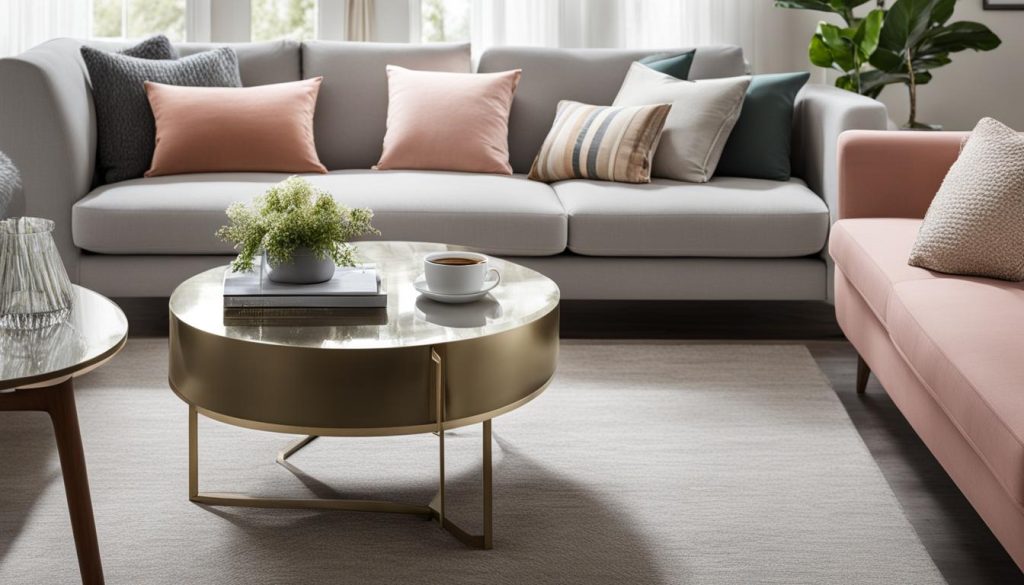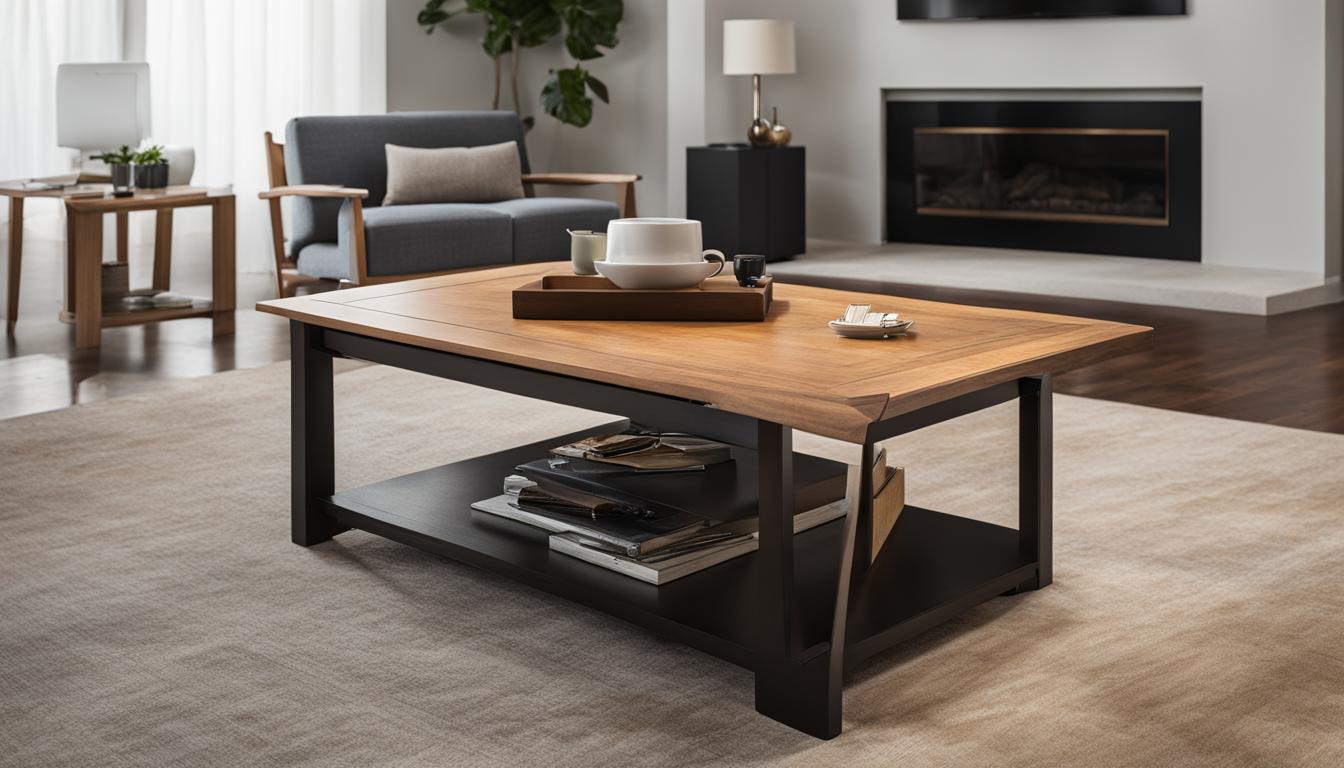A coffee table is a versatile piece of furniture that can serve multiple purposes, including as a surface for board games, snacks, and even as a footrest. The ideal height for a coffee table should allow easy access to objects placed on it and provide a comfortable seating position for users.
Typically, the recommended height for a coffee table is between 16 and 18 inches. However, this can vary depending on the height of the seating and the specific needs of the space. It’s important to consider factors such as the length of the table, the height of the seating, and the overall layout of the room when determining the perfect coffee table height.
Key Takeaways:
- The ideal height for a coffee table is between 16 and 18 inches.
- Consider the height of the seating and the overall layout of the room when determining the perfect coffee table height.
- Factors such as the length of the table and the specific needs of the space should also be taken into account.
- Position the coffee table at least one foot from the couch to allow adequate space for seating and easy access.
- Choose a coffee table shape, style, and size that complements your space and personal preferences.
Factors to Consider When Determining Coffee Table Height
When determining the height of a coffee table, several factors need to be taken into consideration to ensure optimal functionality and aesthetics. The height of the seating it will serve is a crucial factor to consider. A general rule of thumb is to have the tabletop sit one to two inches lower than the seat cushion height. This provides proper clearance for objects placed on the table and prevents them from butting up against the table edge.
For instance, if the seat cushion height is 18 inches, a coffee table height of 16 or 17 inches would be appropriate. On the other hand, if the seat cushion height is 14 inches, a coffee table height of 12 or 13 inches would be more suitable. By following this guideline, you can ensure that the coffee table is at an ergonomic height for comfortable use as a serving or dining surface.
Another important consideration is the specific needs of the users. It’s essential to determine if the coffee table height allows for comfortable access and use based on individual preferences and intended activities. For example, if the coffee table will primarily be used for board games, a slightly lower height may be preferable to ensure ease of reach and prevent strain. On the other hand, if it will primarily be used for dining, a slightly higher height may be more convenient for comfortable seating and eating.
Choosing the right height for your coffee table is crucial for both functionality and aesthetics. By considering the height of the seating it will serve, as well as the specific needs of the users, you can determine the perfect coffee table height. This will ensure easy access to objects placed on the table and provide a comfortable seating position for a seamless living room experience.
| Seating Height (inches) | Ideal Coffee Table Height (inches) |
|---|---|
| 18 | 16-17 |
| 14 | 12-13 |
Ideal Coffee Table Length
When determining the length of a coffee table, it’s essential to consider the proportions and layout of your living room. A coffee table that is too long can make the space feel cramped, while a table that is too short can leave the seating area feeling incomplete. The general rule of thumb is to choose a coffee table that is approximately two-thirds the length of your sofa. This ensures that the table looks proportionate to the seating area and allows for comfortable access from all sides.
For example, if your sofa measures 84 inches wide, an ideal coffee table length would be around 56 inches. This length provides a visually balanced look and allows for ample space for people to move around the table without feeling cramped. However, it’s important to consider the overall size of your living room and the placement of other furniture when determining the length of your coffee table.
To better illustrate the relationship between coffee table length and sofa length, refer to the table below:
| Sofa Length (inches) | Ideal Coffee Table Length (inches) |
|---|---|
| 60 | 40 |
| 72 | 48 |
| 84 | 56 |
| 96 | 64 |
Remember, these measurements are just a guideline, and you may need to adjust the length of your coffee table based on the specific dimensions and layout of your living room. By choosing a coffee table length that complements your sofa and allows for comfortable movement and access, you can create a harmonious and functional living space.
The Importance of Positioning
Properly positioning your coffee table is crucial for creating a functional and aesthetically pleasing living space. The placement of the coffee table affects not only the flow of the room but also the comfort of those using it. By following a few simple guidelines, you can ensure that your coffee table enhances the overall design and functionality of your living room.
First and foremost, it is recommended to position your coffee table at least one foot away from the couch. This allows for adequate space for seating, leg stretching, and easy access to the table. Leaving 12 to 18 inches of floor space between the coffee table and surrounding seating ensures that individuals can move around comfortably without bumping into the table.
In addition to providing sufficient clearance, the positioning of the coffee table should also take into account the overall layout of the room. Consider the size of the room and the location of other furniture when determining where to place the coffee table. It should be positioned in a way that allows for easy navigation and maximizes the functionality of the space.
Examples of Coffee Table Positioning
Here are a few examples of coffee table positioning to help you visualize how to create a well-balanced and functional living room:
- For a large living room with ample space, consider placing the coffee table in the center of the seating area. This creates a focal point and allows for easy access from all sides.
- In a small living room with limited space, position the coffee table against a wall or next to a larger piece of furniture to maximize floor space.
- If you have a sectional sofa, you can place the coffee table in the middle or off to the side, depending on the configuration of the seating. This allows for easy access from multiple angles and creates a cohesive look.
Overall, finding the right position for your coffee table is essential for creating a harmonious and functional living room. By considering the clearance, layout, and size of the room, you can ensure that your coffee table enhances both the functionality and flow of the space.
| Positioning Tips | Advantages |
|---|---|
| Leave at least one foot of clearance between the coffee table and the couch. | Allows for easy access and movement in the seating area. |
| Position the coffee table in a way that maximizes floor space and allows for smooth navigation. | Creates a functional layout and prevents clutter. |
| Consider the size of the room and the location of other furniture when determining the position of the coffee table. | Ensures a well-balanced and cohesive look. |
Selecting the Right Shape and Style
When choosing a coffee table, there are various factors to consider, including the shape and style that best suits your space and personal preferences. The shape of the coffee table can significantly impact the overall aesthetics and functionality of your living room. Rectangular coffee tables are the most common and versatile, fitting well with different seating arrangements. They provide ample surface area for placing items and create a visually balanced look. Round coffee tables, on the other hand, are a great choice for smaller spaces or rooms with square layouts. They allow for better traffic flow and create more open space without sharp corners.
Aside from shape, the style of the coffee table can also make a significant impact on the overall design of your living room. Various styles are available, each with its unique characteristics. Scandinavian coffee tables feature elegant lines, soft curves, and pale woods, creating a visually light and airy look. Industrial coffee tables often incorporate rustic, repurposed wood and metal frames, adding an urban and edgy feel to the space. Japandi coffee tables combine the simplicity of Japanese design with the elegance of Scandinavian aesthetics, resulting in a harmonious and balanced look.
“A coffee table should not only be a functional piece but also a reflection of your personal style.”
Other popular coffee table styles include mid-century, boho, and minimalist. Mid-century coffee tables have unusual shapes, dark wood, and functional storage, adding a fun, kitsch feel to the room. Boho coffee tables feature natural materials, neutral colors, and interesting textures, bringing a cozy and eclectic vibe to the space. Minimalist coffee tables, as the name suggests, offer sleek surfaces, clean lines, and a minimalist aesthetic, perfect for those who prefer a more simplified and streamlined look in their living room.
| Shape | Style |
|---|---|
| Rectangular | Versatile and balanced |
| Round | Space-saving and softer look |
| Scandinavian | Elegant, light, and airy |
| Industrial | Rustic and edgy |
| Japandi | Harmonious and balanced |
| Mid-century | Unusual shapes and kitschy |
| Boho | Natural materials and eclectic |
| Minimalist | Clean lines and streamlined |
Decorating Your Coffee Table
A well-decorated coffee table not only adds style to your living room but also serves as a reflection of your personality. Here are some coffee table decoration ideas to help you create a visually appealing and inviting space:
- Coffee table books: Choose a selection of coffee table books that align with your interests or showcase beautiful photography. Stack them neatly or display them open to your favorite pages for an added touch.
- Plants or flowers: Bring a touch of nature indoors by placing a small potted plant or a vase of fresh flowers on your coffee table. Not only do they add a pop of color, but plants also help purify the air in your living space.
- Mementos or keepsakes: Personalize your coffee table by displaying special mementos or keepsakes that hold sentimental value. These could include family photos, souvenirs from travels, or cherished trinkets.
- Candles: Create a cozy ambiance with candles of different heights and scents. Opt for unscented candles if you prefer a more subtle touch, or choose fragrant candles to fill the room with a delightful aroma.
Remember to keep the size of your coffee table in mind when decorating. You don’t want to overcrowd the table or obstruct the view of your beautiful decorations. Instead, aim for a harmonious balance of objects that complement each other.
Experiment with different arrangements and accessories to find the perfect combination for your coffee table. Don’t be afraid to switch things up from time to time to keep the look fresh and interesting. Finally, let your own personal style shine through in your coffee table decor, making it a true reflection of your unique taste and aesthetic.
| Decoration Idea | Benefits |
|---|---|
| Coffee table books | – Adds personality – Provides visual interest – Conversation starter |
| Plants or flowers | – Brings nature indoors – Adds color and freshness – Purifies the air |
| Mementos or keepsakes | – Personalizes the space – Evokes sentimental value – Adds a personal touch |
| Candles | – Creates a cozy ambiance – Enhances the atmosphere – Adds subtle lighting |

Choosing a Coffee Table to Complement Your Sofa
When selecting a coffee table to complement your sofa, it’s important to consider the color, material, and style of both pieces. The right pairing can enhance the overall aesthetic of your living room and create a cohesive look. For example, if you have a gray sofa, opt for a coffee table with pale woods, silver metals, or white/cream paints to create a harmonious blend. On the other hand, if you have a leather sofa, consider rustic styles with reclaimed pallets and natural wood tops for brown leather, or contemporary metal coffee tables with glass or marble tops for black leather. The goal is to strike a balance between the coffee table and sofa that elevates the visual appeal of your space.
When it comes to sectional sofas, round coffee tables can be an excellent choice. They create more open space, allow for easy movement, and provide access from multiple angles. The round shape softens the overall look and adds a touch of elegance to the room. Additionally, consider the size of your sofa and the available space. A large sectional may require a larger coffee table to maintain proportionality, while a smaller sofa can be paired with a smaller, more compact coffee table.
Remember, the goal is to find a coffee table that complements your sofa, both in terms of style and functionality. By considering color, material, size, and shape, you can achieve a harmonious and visually appealing living room design. Take the opportunity to showcase your personal style and create a space that reflects your unique taste and preferences.
| Sofa Type | Ideal Coffee Table Pairing |
|---|---|
| Gray Sofa | Pale woods, silver metals, white/cream paints |
| Leather Sofa (Brown) | Rustic styles with natural wood tops |
| Leather Sofa (Black) | Contemporary metal coffee tables with glass or marble tops |
| Sectional Sofa | Round coffee table for open space and access from multiple angles |
When selecting a coffee table to complement your sofa, consider factors such as color, material, size, and shape. By finding the perfect pairing, you can create a cohesive and visually appealing living room design that reflects your personal style.
Conclusion
In conclusion, selecting the right coffee table height is crucial for creating a comfortable and aesthetically pleasing living room. By considering the height of the seating, the length of the table, and the overall layout of the room, you can determine the ideal coffee table height. Typically, a coffee table height of 16 to 18 inches is recommended, but it’s important to customize it based on your specific needs.
When choosing a coffee table, also take into account the shape, style, and size that best suits your space and personal preferences. Rectangular coffee tables are versatile and fit well with different seating arrangements, while round coffee tables are perfect for smaller spaces. Additionally, consider the overall style of your living room and choose a coffee table that complements it, whether it be Scandinavian, industrial, Japandi, mid-century, boho, minimalist, or contemporary.
Finally, don’t forget to decorate your coffee table to enhance its visual appeal and add a personal touch. Coffee table books, plants or flowers, mementos or keepsakes, and candles are great options. By following these coffee table selection tips, you can find the perfect coffee table that meets your needs and elevates the style of your living room.
FAQ
How tall should a coffee table be?
The ideal height for a coffee table is between 16 and 18 inches. However, it can vary depending on the height of the seating and the specific needs of the space.
What factors should I consider when determining coffee table height?
Factors to consider include the height of the seating, the length of the table, and the overall layout of the room.
How long should a coffee table be?
The length of a coffee table should be approximately two-thirds the length of the sofa it is paired with.
Where should I position my coffee table?
It is recommended to position the coffee table at least one foot from the couch to allow adequate space for seating, leg stretching, and easy access to the table.
What shape and style of coffee table should I choose?
The choice of shape and style depends on your space and personal preferences. Rectangular coffee tables are versatile, while round tables are great for smaller spaces. There are also various styles to choose from, such as Scandinavian, industrial, Japandi, mid-century, boho, minimalist, and contemporary.
How can I decorate my coffee table?
You can decorate your coffee table with items such as coffee table books, plants or flowers, mementos or keepsakes, and candles to create a visually appealing focal point.
What are some popular coffee table styles?
Popular coffee table styles include Scandinavian, industrial, Japandi, mid-century, boho, minimalist, and contemporary.
How do I choose a coffee table that complements my sofa?
Consider the color, material, and style of both the coffee table and sofa. Options will vary depending on the color and type of sofa.
What are some tips for choosing the right coffee table?
Consider the height and length that best suits your space and seating, as well as the overall style and aesthetic you want to achieve.


